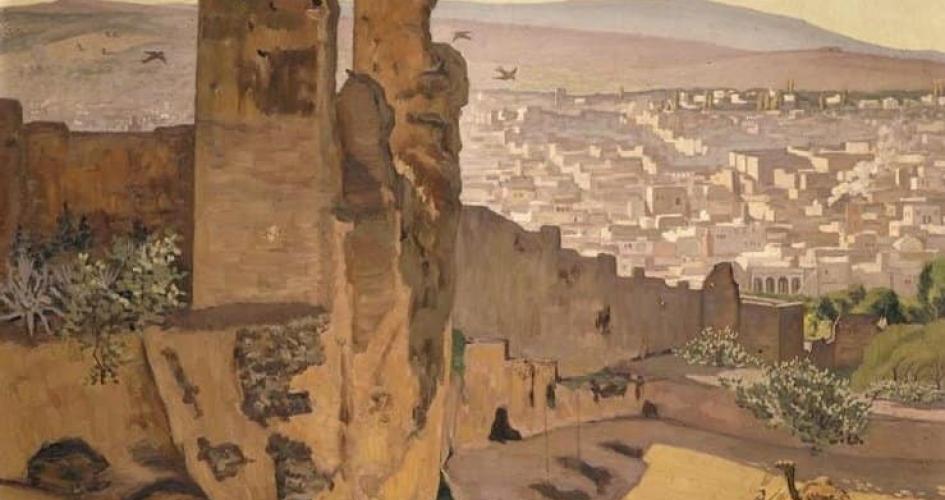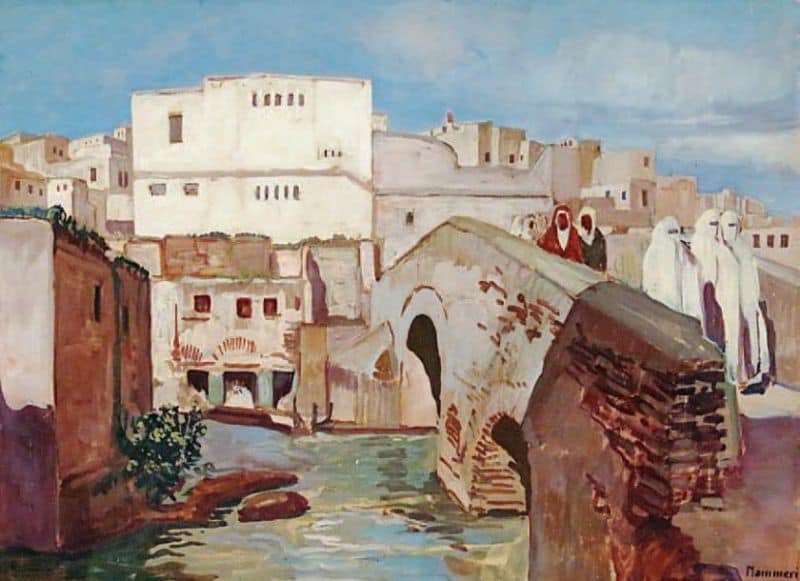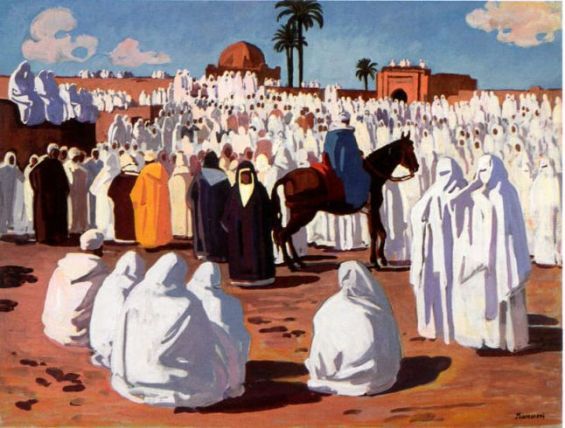He was born in Algeria, but his career as a painter flourished in Morocco, mainly in Fez. In its ancient Medina, where he was a teacher as a primary occupation, he was amazed by the scenes of everyday life. Schoolboys sat around their fqih, the Islamic rector, at an ancient Medina koranic school, the city’s architectural landmarks, mosques, bridges, and souks at the beginning of the 20th century.
He drew Morocco like a Moroccan, but his hometown was further east on the map. Azouaou Mammeri was a Kabyle, born circa 1892 to a prestigious family of Caids in Ait-Yenni, a commune in the Tizi Ouzou province in northern Algeria. Most precisely, he was raised in Taourirt-Mimoun in the Kabilya mountains of southern Algiers, in an Algeria under French rule.
A teacher in French Algeria
His family favored education, enrolling him in a francophone educational system. He studied under «an old French schoolmaster, become almost Kabyle himself after spending thirty years in the region», wrote Jill Beaulieu and Mary Roberts in their «Orientalism's Interlocutors: Painting, Architecture, Photography», (Duke University Press).
He then qualified for Algeria's École Normale de Bouzareah, a training college for schoolteachers. Three years later, he was appointed to teaching positions in several parts of Algeria from 1910 to 1913.

Self-Taught, his painter side started to peek. He decided to send one of his amateur paintings to the inspector of artisric education in Algeria Prospert Ricard. The latter advised him to consult two French teachers in Taourirt-Mimoun. One of them was Swiss painter, drawer and illustrator Edouard Herzig, who lived in French Algeria and made paintings of Kabylie.
Later in Life, the young teacher, and during a posting in 1913 in Gouraya, a town and commune in Tipaza Province in northern Algeria, he met with French Orientalist Leon Carre. The latter was his mentor for eight months and influenced his career in painting.
Discovered by Morocco
For six more years, and several other postings, Mammeri practiced primary school teaching, until he was discovered by the Moroccan authorities. According to Beaulieu and Roberts, the talent of the young Algerian teacher was recognized by Morocco, which hired him as drawing master at Rabat’s Collège Franco-Musulman.
In 1916, he left Algeria for Morocco, where he worked as a teacher. He moved to Fez, where his cousin Si Mohammed Mammeri worked as tutor for young prince Moulay Mohammed ben Youssef. He later became a vizier following the ascendence of Sultan Moulay Mohammed to the throne in 1927.
In the majestic city of Fez, and thanks to his experience in teaching, Mammeri opened a small primary school where he taught children of the Fassi elite in French. In the city, his knack for painting took wing. Thanks to the nature of the imperialistic medina.
«Azouaou Mammeri found in Fez ‘a city of 100,000 inhabitants where Arabs were not ‘wogs’ (bicots), but where they possessed money, prestige and power; where everyone went to the mosque, where the purest Arabic was spoken; where one saw elegantly-clad men had been able to see in Algiers», Beaulieu and Roberts wrote.
In the city he started sketching to illustrate articles he wrote for French magazine France-Maroc. He wrote articles about teaching, education, France, and used his own drawings to illustrate that. These drawings have reportedly caught the attention of French Resident Louis Hubert Gonzalve Lyautey.

His paintings mimicked the ordinary, traditional everyday life of people in Fez, their small koranic schools, their houses, streets and markets. His career as a painter flourished and his work was described as an emulation of Western art, with techniques that resembled that of the western school, given his upbringing and training.
He is believed to be the first Algerian painter to create oil paintings, Mammeri used a «plein air style that emphasized nuances of natural light», wrote Gitti Salami, Monica Blackmun Visona and Dana Arnold in «A Companion to Modern African Art».
In Morocco, in 1918, he held an exhibition at the new Excelsion Hotel in Casablanca, alongside European Orientalists. After a teaching career in Fez and a number of paintings, Mammeri returned to Algeria in the 1920s. He was appointed Caid of his hometown, as family tradition happened to be.

But by 1927, he returned to Morocco, where he continued painting all while climbing the ladder of art academia. In Rabat, he was appointed in 1928 regional inspector of indeginous art.
He then moved to Marrakech, where he served as inspector of Moroccan arts. In the city, he founded the Dar Si Said museum for indigenous arts after he retired in 1948. The museum was the residence of Si Said ibn Musa, a vizier and minister of defence under his brother Ba Ahmad ibn Musa, who was the Grand Vizier and effective ruler of Morocco during the same period under Sultan Moulay Abdelaziz (ruled 1894–1908).
Mammeri left behind hundreds of paintings, most of which were sceneries of Moroccan cities, such as Fez, Essaouira, Casablanca and Rabat, becoming the most Moroccan of all Algerian artists.





 chargement...
chargement...













